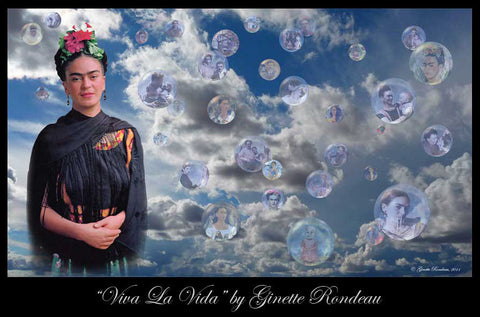The Life of Frida Kahlo
Written by John Trausch
Frida Kahlo, artist, activist, feminist, and an iconic image of Mexico, has become much more popular in her after-life than when she walked the earth.
Born in 1907 in Coyocoan, Mexico City, Frida grew up in the family’s home, which is today the landmark Casa Azul (“Blue House”). She constantly battled health issues, a factor that surfaces again and again in her self-portraits. Contracting polio at the age of six, she was bedridden for nine months. The disease caused her right leg and foot to grow thinner than her left one, leaving her with a life-long limp. She took to wearing long skirts to cover her legs.
In school, she was recognized for her outspokenness and courage. It was there that she met the famous Mexican muralist Diego Rivera, who was working on a mural on the school campus. Frida was said to tell a friend that she would marry Diego someday. She did. Twice.
But health issues continued to rein on Frida; she then suffered a near-fatal bus accident when the bus she was riding in was crashed into by a streetcar, impaling a steel handrail in Frida’s hip. Her spine and pelvis were fractured, she was hospitalized for several weeks an in a full body cast for several months.
Bed-ridden at home, Frida began painting. Her parents constructed a special easel made for her so she could paint in bed.

Frida met Rivera again shortly thereafter, and she asked him for an honest evaluation of her work. He gave it to her, and it was harsh. But he then took her under his wing, and shortly after, a romantic relationship blossomed. Frida and Diego were soon married. Frida’s art took a decided back-seat to the more accomplished and famous Diego, and the couple traveled to San Francisco, New York City, and Detroit as Diego worked for his commissions.
 Frida began to emerge from Diego’s shadow in the late 1930s when she started experimenting with surrealism. In 1938 she had an exhibition in New York City gallery.
Frida began to emerge from Diego’s shadow in the late 1930s when she started experimenting with surrealism. In 1938 she had an exhibition in New York City gallery. The following year Frida was invited by her surrealist mentor Andre Breton to come to Paris. Her works were exhibited there, and she rubbed elbows with artists such as Marc Chagall, Piet Mondrian, and Pablo Picasso. She and Rivera got divorced that year, and she completed one of her most famous paintings, The Two Fridas (1939). The divorce didn’t last, and the two were remarried in 1940. Not much changed, as they still keep separate lives and houses.
In 1944, Frida Kahlo painted one of her most famous portraits, The Broken Column. Here, she depicted herself naked and split down the middle; her spine shattered. A surgical brace with nails through her body shows the consistent pain she went through. Frida Continually sought surgeries and other medical treatment for her chronic pain…but nothing worked. Yet she continued to paint through her pain, always remaining politically active despite her constant health issues.

In 1953, she had a solo exhibition in Mexico. Bedridden, she made sure she showed up on the exhibition’s opening ceremony. She arrived by ambulance and celebrated in a bed the gallery set up for her.
Frida passed away at the age of 47. The Blue House became a museum in 1958. In the 1970s, interest in her work was renewed by the feminist movement. In 2002, the movie “Frida” was released, becoming a popular hit and exposing her to yet another new generation of admirers.
Artwork by Ginette Rondeau in Tribute to Frida's Afterlife. May she rest in peace surrounded by love.



Leave a comment